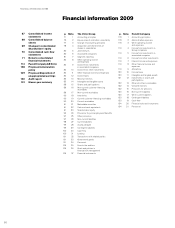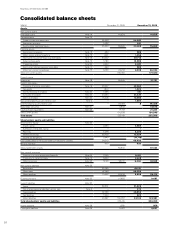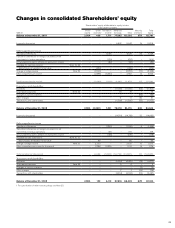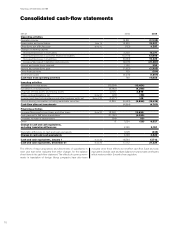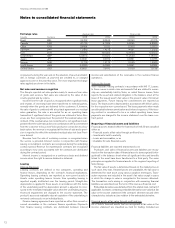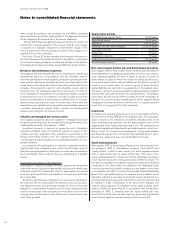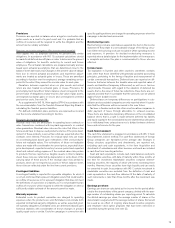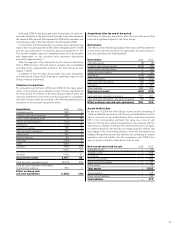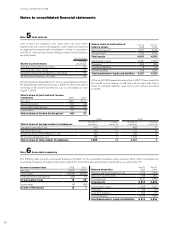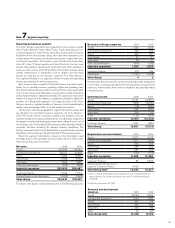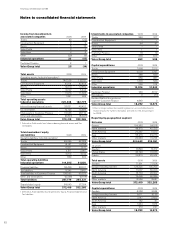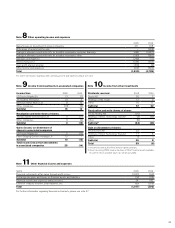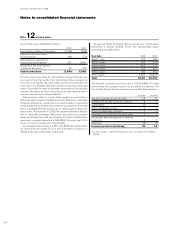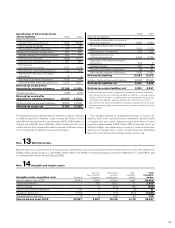Volvo 2009 Annual Report Download - page 80
Download and view the complete annual report
Please find page 80 of the 2009 Volvo annual report below. You can navigate through the pages in the report by either clicking on the pages listed below, or by using the keyword search tool below to find specific information within the annual report.
Notes to consolidated financial statements
Note 2 Key sources of estimation uncertainty
Volvo’s significant accounting principles are set out in note 1, Account-
ing Principles and conform to IFRS as endorsed by the EU. The prep-
aration of Volvo’s Consolidated Financial Statements requires the use
of estimates, judgements and assumptions that affect the reported
amounts of assets, liabilities and provisions at the date of the financial
statements and the reported amounts of sales and expenses during
the periods presented. In preparing these financial statements, Volvo’s
management has made its best estimates and judgements of certain
amounts included in the financial statements, giving due consider-
ation to materiality. The application of these accounting principles
involves the exercise of judgement and use of assumptions as future
uncertainties and, accordingly actual results could differ from these
estimates. In accordance with IAS 1, preparers are required to provide
additional disclosure of accounting principles in which estimates,
judgments and assumptions are particularly sensitive and which, if
actual results are different, may have a material impact on the finan-
cial statements. The accounting principles applied by Volvo that are
deemed to meet these criteria are discussed below:
Impairment of goodwill, other intangible assets
and other non-current assets
Property, plant and equipment, intangible assets, other than goodwill,
and certain other non-current assets are amortized and depreciated
over their useful lives. Useful lives are based on management’s esti-
mates of the period that the assets will generate revenue. If, at the
date of the financial statements, there is any indication that a tangible
or intangible non-current asset has been impaired, the recoverable
amount of the asset should be estimated. The recoverable amount is
the higher of the asset’s net selling price and its value in use, esti-
mated with reference to management’s projections of future cash
flows. If the recoverable amount of the asset is less than the carrying
amount, an impairment loss is recognized and the carrying amount of
the asset is reduced to the recoverable amount. Determination of the
recoverable amount is based upon management’s projections of
future cash flows, which are generally made by use of internal business
plans or forecasts. While management believes that estimates of
future cash flows are reasonable, different assumptions regarding
such cash flows could materially affect valuations. Intangible and
tangible non-current assets amounted to 117,296 (126,657) whereof
23,827 (24,813) represents goodwill. For Goodwill and certain other
intangible assets with indefinite useful lives, an annual, or more
frequently if necessary, impairment review is performed. Such an
impairment review will require management to determine the fair value
of Volvo’s cash generating units, on the basis of projected cash flows
and internal business plans and forecasts. Overvalues differ between
the business areas and they are, to a varying degree, sensitive to
changes in the business environment. Volvo has since 2002 per-
formed a similar impairment review. No impairment charges were
required for the period 2002 until 2009. See note 14 for the alloca-
tion and impairment tests of goodwill.
Revenue recognition
Revenue from the sale of products is recognized when significant
risks and rewards of ownership have been transferred to external
parties, normally when the products are delivered to the customers. If,
however, the sale of products is combined with a buy-back agreement
or a residual value guarantee, as described below regarding residual
value risks, the sale is accounted for as an operating lease transaction
under the condition that significant risks of the products are retained
by Volvo. In certain cases Volvo enters into a buy-back agreement or
residual value guarantee after Volvo has sold the product to an inde-
pendent party or in combination with an undertaking from the cus-
tomer that in the event of a buy-back to purchase a new Volvo product.
In such cases, there may be a question of judgement regarding
whether or not significant risks and rewards of ownership have been
transferred to the customer. If it is determined that such an assess-
ment was incorrect, Volvo’s reported revenue and income for the
period will decline and instead be distributed over several reporting
periods.
Residual value risks
In the course of its operations, Volvo is exposed to residual value risks
through operating lease agreements and sales combined with repur-
chase agreements. Residual value commitments amount to SEK
14,954 (16,422) at December 31, 2009. Residual value risks are
reflected in different ways in the Volvo consolidated financial statements
depending on the extent to which the risk remains with Volvo.
In cases where significant risks pertaining to the product remain
with Volvo, the products, primarily trucks, are generally recognized in
the balance sheet as assets under operating leases. Depreciation
expenses for these products are charged on a straight-line basis over
the term of the commitment in amounts required to reduce the value
of the product to its estimated net realizable value at the end of the
commitment. The estimated net realizable value of the products at the
end of the commitments is monitored individually on a continuing
basis. A decline in prices for used trucks and construction equipment
may negatively affect the consolidated operating income. High inven-
tories in the truck industry and the construction equipment industry
and low demand may have a negative impact on the prices of new and
used trucks and construction equipment. In monitoring estimated net
realizable value of each product under a residual value commitment,
management makes consideration of current price-level of the used
product model, value of options, mileage, condition, future price
de terioration due to expected change of market conditions, alterna-
tive distribution channels, inventory lead-time, repair and recondition-
ing costs, handling costs and overhead costs in the used product div-
isions. Additional depreciations and estimated impairment losses are
immediately charged to income.
The total risk exposure for assets under operating lease is reported as
current and non-current residual value liabilities. See notes 26 and 27.
If the residual value risk commitment is not significant, independent
from the sale transaction or in combination with a commitment from
the customer to buy a new Volvo product in connection to a buy-back
option, the asset is not recognized on balance. Instead, the risk
ex posure is reported as a residual value provision equivalent to the
estimated residual value risk. See note 25.
To the extent the residual value exposure does not meet the defin-
ition of a provision, the remaining residual value risk exposure is
reported as a contingent liability. See note 29.
Deferred taxes
Under IFRS, deferred taxes are recognized for temporary differences,
which arise between the taxable value and reported value of assets
and liabilities as well as for unutilized tax-loss carryforwards. Volvo
records valuation allowances for deferred tax assets where manage-
ment does not expect such assets to be realized based upon current
forecasts. In the event that actual results differ from these estimates
or management adjusts these estimates in future periods, changes in
FINANCIAL INFORMATION 2009
76


